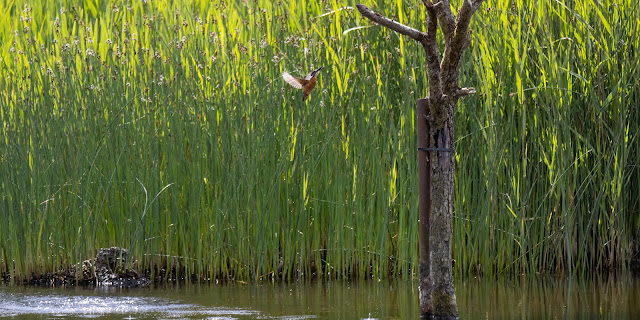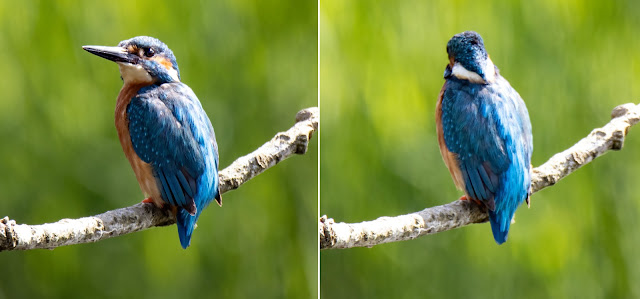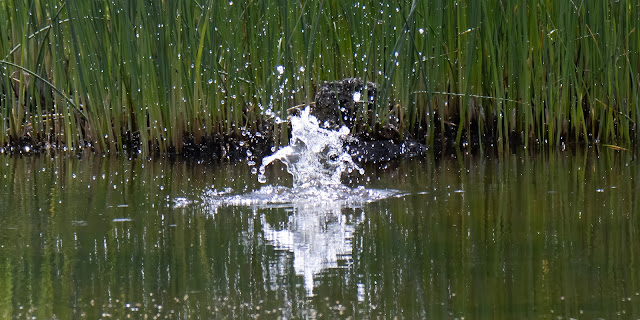So, also on the advice of the Flambards Innkeeper, we went to nearby Teifi Marshes Nature Reserve.
 |
| The Kingfisher Pond |
The reserve is situated on the floor of the wide pre-glacial channel left by the former course of the Afon Teifi (Teifi River) that is now occupied by the Afon Piliau, which meanders through the marshes in a narrow but deceptively deep cut.
 |
| The River Piliau |
Of course, we went looking for birds.
 |
| Giant willow Otter with a Parkrun sign |
When we reached the carpark, however, we encountered the Vitality Parkrun. Fortunately, it was over a short course and didn’t interfere with our walk. The runners all seemed local; they knew each other and weren't too intense.
There were birds, but most were the frustrating kind that likes to sing loudly while darting in and out of thickets and trees.
We saw some Eurasian Bullfinches, including the brilliantly colored male (we think we had also seen one near Pentre Ifan) as well.
 |
| My attempt to photograph the male Eurasian Bullfinch failed, but I did get the female |
 |
| A Dunnock |
 |
| Lots of Eurasian Blackbirds, female and male |
 |
| Eurasian Magpies and Common Wood-Pigeons |
 |
| Common Chiffchaffs (love that name) |
 |
| Eurasian Blue Tits |
 |
| A Great Tit |
 |
| European Robins |
 |
| Another hard-to-photograph Red Kite (I thought they were rare, but not so much) |
 |
| A Gray Heron |
 |
| Yellow-legged Gulls |
 |
| As far as animals go, we had to be satisfied with Gray Squirrels |
When we went into the Welsh Wildlife Centre, which is situated there, we saw a dry-erase board with sightings listed.
 |
| A beautiful building; Photo: Welsh Wildlife Centre |
Common Kingfisher
We quietly crept into the blind and took a seat on the bench right in the middle. It was only about 15 minutes in, when this gorgeous bird landed on a perch right in front of us.
It posed for a few minutes before flying to another perch farther away and then proceeded to fish, eat fish and fish some more. It was a wee bit too far away for great pictures, but so fun to watch.
Also known as the Eurasian Kingfisher and River Kingfisher, the Common Kingfisher has seven subspecies recognized within its wide distribution across Eurasia and North Africa. The Western European subspecies is the only Kingfisher found in Wales.
Sparrow-sized, it has a typical short-tailed, large-headed Kingfisher profile. The upper parts are bright metallic turquoise blue, the belly and malars are coppery orange, the throat is white and the feet are bright red/organge. The bill is long and thick.
The Common Kingfisher feeds mainly on fish. It hunts from a perch – a branch, post or riverbank – three to seven feet above the water. Teifi had placed multiple perches in the water outside the blind to facilitate feeding (by the Kingfishers) and viewing (by us).
To hunt, the Kingfisher points its bill down as it searches for prey.
 |
... and seizes its prey usually no deeper than 10 inches below the surface |
The Common Kingfisher has a transparent third eyelid and a specialized retina that enable it to see prey underwater.
Once it catches a fish, it rises beak-first to the surface, flies back to the perch and adjusts the fish so that it is holding it near the tail. Then, it kills the fish by beating it against the perch and swallows it head-first.
A few times each day, the Kingfisher regurgitates a pellet of fish bones and other indigestible remains.
 |
| The king of the river |
Like all Kingfishers, it is highly territorial. Because it must eat around 60 percent of its body weight each day, it is essential to have control of a suitable stretch of river. It is solitary for most of the year, roosting alone in heavy cover. If another Kingfisher enters its territory, both birds display from perches, and fights may occur, in which a bird will grab the other's beak and try to hold it underwater.
The one we saw was most likely part of a nesting pair; the board had said that fledglings had been seen.
The early days for fledged juveniles are hazardous; during its first dives into the water, about four days after leaving the nest, a fledgling may become waterlogged and drown. Many young will not have learned to fish by the time they are driven out of their parents' territory, and only about half survive more than a week or two.
Most Kingfishers die of cold or lack of food, and a severe winter can kill a high percentage of the birds. Summer floods can destroy nests or make fishing difficult, resulting in starvation of the brood. Only a quarter of the young survive to breed the following year, but this is enough to maintain the population. Likewise, only a quarter of adult birds survive from one breeding season to the next. The oldest bird on record was 21 years old.
 |
| If it hadn't flown away, we might have stayed forever |
 |
| On the right is a Chinese Kingfisher headdress; Photo: Invaluable.com |
Trip date: June 6 - 20, 2024










No comments:
Post a Comment